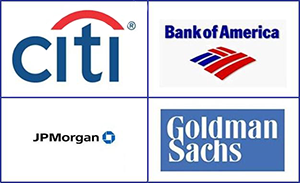By Pam Martens and Russ Martens: July 21, 2016
 On July 14, when America’s biggest bank by assets reported its second quarter earnings, this headline ran at the New York Times: “JPMorgan Chase Has Strong Quarter as Earnings Top Estimates.”
On July 14, when America’s biggest bank by assets reported its second quarter earnings, this headline ran at the New York Times: “JPMorgan Chase Has Strong Quarter as Earnings Top Estimates.”
CNBC, a unit of NBCUniversal, used the same criteria in its headlines to report the earnings of Citigroup, Bank of America and Morgan Stanley — putting a positive spin in the headline because the earnings had topped what analysts were expecting – rather than the far more meaningful, and traditional, measure of whether earnings had beaten the same quarter a year earlier. CNBC’s headlines read:
Citigroup earnings handily top Wall Street expectations: CNBC-July 15, 2016
Bank of America earnings top expectations: CNBC-July 18, 2016
Morgan Stanley solidly beats earnings expectations: CNBC-July 20, 2016
This is hubris of the highest order. Publicly traded companies simply guide research analysts toward lowered expectations on their upcoming quarterly earnings so that the companies can surprise on the upside and get these kinds of misleading headlines in the all-to-willing New York media – which has a vested interest in making everything appear rosy in the Big Apple. (New York media is dependent on fat Wall Street profits to boost the price of their own publicly traded shares since ad revenue in New York is linked to the health of Wall Street.)
One would never know by these headlines that big bank earnings were actually down year over year – and in some cases, down dramatically. JPMorgan Chase earned $6.2 billion in the second quarter of 2016 versus $6.29 billion in the second quarter of 2015.
The news was far worse at Citigroup, despite the rosy headline at CNBC. Citigroup’s second quarter profit fell 17.5 percent year over year, to $4 billion from $4.85 billion in the second quarter of 2015. Its revenues were the lowest in 14 years according to S&P Capital IQ.
At Bank of America, profit fell to $4.23 billion from $5.3 billion in the second quarter of 2015, a sharp decline of 20 percent.
Morgan Stanley reported a year over year decline of 8 percent, with profits in the second quarter of 2016 falling to $1.67 billion from $1.82 billion in the second quarter of 2015.
Now news of jobs cuts is spilling out with the Wall Street Journal reporting that Bank of America will make “$5 billion in annual cost cuts by 2018 as part of its strategy to deal with persistently low interest rates that are eating away at lenders’ profitability.”
The New York Post is calling job cuts at Goldman Sachs the worst since the financial crisis in 2008. Fortune’s Stephen Gandel reported two days ago that Goldman had slashed a whopping “1,700 positions in the past three months.”
Something else one won’t find in those smiley-face headlines is the fact that Wall Street is not only bleeding profits and jobs but it’s also bleeding equity capital – the only thing that separates the word “bank” from the word “bankruptcy.” While the Dow Jones Industrial Average and Standard and Poor’s 500 Indices may be setting new highs, the big Wall Street banks are decidedly not.
Over the past 52 weeks, Goldman is down from a share price of $214.61 to an open this morning of $162.55 – a decline of 24 percent. Bank of America is off 22 percent from its 52-week high, based on today’s open. Morgan Stanley and Citigroup are in decidedly worse shape with declines of 28 percent and 27 percent, respectively, from their 52 week highs versus their share price at the open of the New York Stock Exchange this morning. Add this all up and you’re talking about tens of billions of dollars in equity capital vaporizing.
On July 6, the Wall Street Journal’s David Reilly reported that 20 of the biggest global banks had shed $465 billion, almost half a trillion dollars, in equity capital according to FactSet data. Wall Street On Parade spotted the trend on January 19 of this year with the headline “Big Bank Stocks Have Been Crushed: Here’s Why,” noting at the time that “the minute U.S. corporate media tells you that ‘the selloff isn’t about worries of banks blowing up,’ you know the worries are about banks blowing up.” We also pointed out that the reason these banks trade as a herd in a downward spiral is that, despite the contagion lessons of 2008, Federal banking regulators like the Office of the Comptroller of the Currency and the Federal Reserve have done nothing to end the interconnectedness between these banks, who are counterparties to each other’s derivatives and other intrafinancial assets and liabilities.
Finally, if you stood on a corner on Main Street and surveyed 100 people as to whether corporate earnings are good right now in America, our bet is that a majority would say “yes” based on reading headlines about the new highs being set in the Dow and S&P.
Missing in the bold headlines on the front covers of newspapers is the fact that this quarter will mark the fourth consecutive quarter that S&P earnings have declined. To most rational folks, that sounds like an entrenched trend. On July 7, S&P Capital IQ reported that this four-quarter decline marks an “occurrence that hasn’t happened since 2009.” The fact that the decline is expected to occur in six sectors (as it did in the first quarter of this year) also hasn’t happened since the height of the financial crisis in 2009. Those six sectors are projected to be energy, materials, financials, technology, consumer staples, and telecom.

